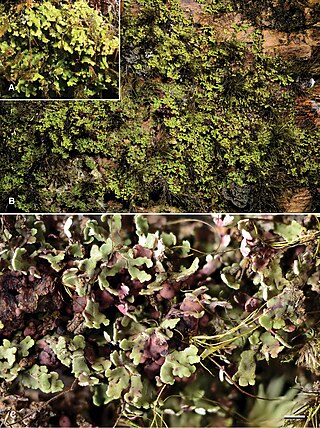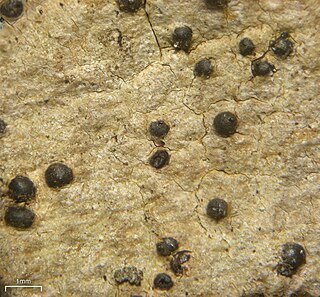
The Pyrenulales are an order of ascomycetous fungi within the class Eurotiomycetes and within the subphylum Pezizomycotina.

Krogia is a genus of corticolous lichens in the family Ramalinaceae. It occurs in tropical humid forests and rainforests. The genus was circumscribed by Norwegian lichenologist Einar Timdal in 2002, with Krogia coralloides assigned as the type species.
Sulcopyrenula is a genus of lichen-forming fungi in the family Pyrenulaceae. It contains five species. The genus was circumscribed by Hiroshi Harada in 1999, with Sulcopyrenula staurospora assigned as the type species. It is distinguished from other genera in the Pyrenulaceae by its longitudinally grooved ascospores.
Mazaediothecium is a genus of calicioid lichens in the family Pyrenulaceae. It has four species. The genus was circumscribed by Dutch lichenologist André Aptroot in 1991, with Mazaediothecium rubiginosum assigned as the type species.

Lithothelium is a genus of lichen-forming fungi in the family Pyrenulaceae. Most of the species are found in tropical climates, and are usually corticolous (bark-dwelling) or saxicolous (rock-dwelling). The genus was circumscribed by Swiss botanist Johannes Müller Argoviensis in 1885.
Septotrapelia is a genus of lichen-forming fungi in the family Pilocarpaceae. It has four species. It was validly published as a genus in 2007 by lichenologists André Aptroot and Jose-Luis Chaves.

Chiodecton is a genus of lichens in the family Roccellaceae. The genus was circumscribed by the lichenologist Erik Acharius in 1814, with Chiodecton sphaerale assigned as the type species.

Anisomeridium is a genus of lichens in the family Monoblastiaceae. The type species was originally named Arthopyrenia xylogena by Swiss botanist Johannes Müller Argoviensis in 1883; in 1928, Maurice Choisy defined the genus Anisomeridium, designating A. xylogena the type species.

Psoroglaena is a genus of lichen-forming fungi in the family Verrucariaceae. The genus was circumscribed by Johann Müller Argoviensis in 1891, with Psoroglaena cubensis assigned as the type species.

The Trypetheliaceae are a family of mainly lichen-forming fungi in the order Trypetheliales. The family consists almost exclusively of corticolous (bark-dwelling), crustose lichens with an almost strictly tropical distribution.
Traponora is a genus of lichen-forming fungi in the family Lecanoraceae. The genus was circumscribed in 2009 by Dutch lichenologist André Aptroot, with the Papua New Guinean Traponora asterella assigned as the type, and at that time, only species. Four newly described species were added to the genus in a 2009 publication, a species formerly in Pyrrhospora was transferred to the genus in 2017, and a new species from Australia added in 2018. Traponora lichens are predominantly from Australasia, with all species but one known to occur in Papua New Guinea.
Harpidium is a genus of lichen-forming fungi in the family Harpidiaceae. The genus contains three species. Harpidium was circumscribed in 1855 by German lichenologist Gustav Wilhelm Körber, with Harpidium rutilans assigned as the type species.
Aptrootia is a genus of fungi in the family Trypetheliaceae. It has three species. The genus was circumscribed by Robert Lücking and Harrie Sipman in 2007, with Aptrootia terricola assigned as the type species. This species, originally described by Dutch mycologist André Aptroot as a species of Thelenella, is known from Papua New Guinea and Costa Rica. Later molecular work showed that the species did not belong in Thelenella, but rather, in the Trypetheliaceae, with a sister taxon relationship to a branch including Bathelium and a lineage containing Trypethelium floridanum. The new genus name honours Aptroot, "in recognition of his numerous contributions to tropical lichenology".

Architrypethelium is a genus of lichen-forming fungi in the family Trypetheliaceae.
Pseudopyrenula is a genus of lichen-forming fungi in the family Trypetheliaceae.
Clypeopyrenis porinoides is a species of corticolous (bark-dwelling) lichen in the family Pyrenulaceae. Found in Costa Rica, where it grows primarily on tree trunks and the understory of primary forests, it was described as new to science in 2011. Closely resembling some Porina species, this lichen is characterised by its light greyish-green surface and distinctive perithecia that set it apart from its close relative, Clypeopyrenis microsperma.

Thelenella is a genus of lichen-forming fungi in the family Thelenellaceae. It has 30 species. The genus was circumscribed by Finnish lichenologist William Nylander in 1855, with Thelenella modesta assigned as the type species.

Robert Lücking is a German lichenologist. He earned his master's and PhD from the University of Ulm, focusing on the taxonomy, ecology, and biodiversity of foliicolous lichens. He has received numerous awards for his work, including the Mason E. Hale Award for his doctoral thesis, the Augustin Pyramus de Candolle prize for his monograph, and the Tuckerman Award twice for his publications in the scientific journal The Bryologist. Since 2015, he has been serving as the curator of lichens, fungi, and bryophytes at the Berlin Botanical Garden and Botanical Museum. Several lichen species and a genus have been named in his honour.
Aspidothelium is a genus of lichen-forming fungi in the family Thelenellaceae. All species in the genus have a tropical distribution and are crustose with a chlorococcoid photobiont partner. Most Aspidothelium species are foliicolous (leaf-dwelling), although some corticolous (bark-dwelling) species are known, as well as a single saxicolous (rock-dwelling) member.
Megalotremis is a genus of lichen-forming fungi in the family Monoblastiaceae. It has 16 species. The genus was circumscribed by Dutch lichenologist André Aptroot in 1991, with Megalotremis verrucosa assigned as the type species. Megalotremis is a pyrenolichen genus, meaning its species have perithecioid ascocarps: spherical or flask-shaped, sessile or partly immersed in the thallus, with a single opening (ostiole) and enclosed by a distinct wall.









